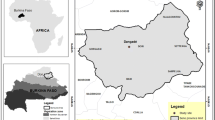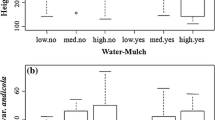Abstract
The aim of this study was to evaluate the effect of organic amendment on the germination and growth patterns of Jatropha curcas L. on completely barren and degraded land in the Sahelian area of Burkina Faso. Prior to the field trials, laboratory germination tests were undertaken to explore the impact of different pre-treatments on germination of Jatropha seeds. Seeds soaked in water for 24 h had the highest mean rate of germination (86%) while seeds that were pre-treated with sulphuric acid did not germinate. The results of the field experiment showed that plant growth and biomass development were significantly enhanced by organic amendment compared to the control. With direct seeding, 20% of the plants treated with organic manure survived after 2 years, while all seedlings of the control plot perished. In the plantations, 30% of the untreated seedlings remained alive whereas only 5% of the plants survived with amendment. The trials in unfenced plots were decimated by livestock grazing and trampling 2 months after the beginning of the experiment. This emphasizes the need to protect Jatropha plants at an early stage of their development from roaming animals. Organic amendment attracted humivorous termites, which were destructive to the seedlings. The use of pesticides may be necessary to control this problem. When directly seeded, plants of the control plots demonstrated poor growth and became rapidly diseased, further accelerating their decline. The low survival rates (5–30%) and meagre seedling performance, even for the amended plots, may be an indication that Jatropha is unsuited to severely degraded lands like the zippelé, and cannot be expected to give good yields and the claimed environmental and socio-economic benefits. However, we recommend that the performance of Jatropha on the zippelé should be further tested with other soil and water conservation techniques (half-moon, tillage, etc.) that have been shown to enhance crop production and yield on degraded lands in the Sahelo-Sudanian zone of West Africa. The impact of seed provenance on the outcome of this study is unknown. Therefore, further experiments should embrace seeds from different sources, including genotypes that are more adapted to dry conditions and might therefore show improved performance.





Similar content being viewed by others
References
Achten WMJ, Verchot L, Franken YJ, Mathijs E, Singh VP, Aerts R, Muys B (2008) Jatropha bio-diesel production and use. Biomass Bioenergy 32:1063–1084
Achten WMJ, Maes WH, Reubens B, Mathijs E, Singh VP, Verchot L, Muys B (2010a) Biomass production and allocation in Jatropha curcas L. seedlings under different levels of drought stress. Biomass Bioenergy 34:667–676
Achten WMJ, Nielsen LR, Aerts R, Lengkeek AG, Kjaer ED, Trabucco A et al (2010b) Towards domestication of Jatropha curcas: a review. Biofuels 1:91–107
Amede T, Menza M, Awlachew BS (2011) Zai improves nutrient and water productivity in the Ethiopian highlands. Exp Agric 47:7–20. doi:10.1017/S0014479710000803
Ayoola OT, Adeniyan ON (2006) Influence of poultry manure and NPK fertilizer on yield and yield components of crops under different cropping systems in south west Nigeria. Afr J Biotechnol 5:1386–1392
Ayuke FO (2010) Soil macrofauna functional groups and their effects on soil structure, as related to agricultural management practices across agroecological zones of Sub-Saharan Africa. Dissertation, Wageningen University, Netherlands
Bayen P (2010) L’impact de la restauration des sols sur la productivité du Sorgho: cas du zaï amélioré au Yatenga. Mémoire de DEA, Université de Ouagadougou
Brittaine R, Lutaladio N (2010) Jatropha: a smallholder bioenergy crop: the potential for pro-poor development. Integrated Crop Management, vol 8. Food and Agriculture Organization of The United Nations, Rome, pp 114
Carels N (2009) Jatropha curcas: a review. Adv Bot Res 50:39–86
ClimateDiagrams (2009) http://climatediagrams.com/africa/burkina_faso/gaoua.htm. Accessed 29 June 2011
Conedera M, Bomio-Pacciorini N, Bomio-Pacciorini P, Sciacca S, Grandi L, Boureima A, Vettraino AM (2010) Reconstitution des écosystèmes dégradés sahéliens. Bois Forêts Trop 304:61–71
Divakara BN, Upadhyaya HD, Wani SP, Gowda CLL (2009) Biology and genetic improvement of Jatropha curcas L.: a review. Appl Energy. doi:10.1016/j.apenergy.2009.07.013
Fairless D (2007) Biofuel: the little shrub that could may be. Nature 449:652–655
FAO (2011) http://www.fao.org/nr/land/sustainable-land-management/farmer-field-school/agro-pastoral-ffs-project-home/ffs/en/. Accessed 27 June 2011
Fatondji D, Martius C, Zougmore R, Vlek PLG, Bielders CL, Koala S (2009) Decomposition of organic amendment and nutrient release under the Zai technique in the Sahel. Nutr Cycl Agroecosyst 85:225–239
Fontes J, Guinko S (1995) Carte de la végétation et de l’occupation du Burkina Faso. Note explicative. Toulouse: Ministère de la coopération française 53
Francis G, Edinger R, Becker K (2005) A concept for simultaneous wasteland reclamation, fuel production, and socio-economic development in degraded areas in India: need, potential and perspectives of Jatropha plantations. Nat Resour Forum 29:12–24
Freschet GT, Masse D, Hien E, Sall S, Chotte JL (2008) Long-term changes in organic matter and microbial properties resulting from manuring practices in an arid cultivated soil in Burkina Faso. Agric Ecosyst Environ 123:175–184
Hammer Ø, Harper DAT, Ryan PD (2001) PAST: paleontological statistics software package for education and data analysis. Palaeontol Electron 4(1). http://palaeo-electronica.org/2001_1/past/issue1_01.htm
Heller J (1996) Physic nut. Jatropha curcas L. Promoting the conservation and use of underutilized and neglected crops, vol 1. Institute of Plant Genetics and Crop Plant Research, Gatersleben and International Plant Genetic Resources Institute (IPGRI), Rome
Henning R (2002) Using the indigenous knowledge of Jatropha—the use of Jatropha curcas oil as raw material and fuel. IK Notes 47. World Bank, Washington, DC
INSD (Institut National de la Statistique et de la Démographie) (2008) Recensement Général de la Population et de l’Habitation de 2006, Résultats définitifs. Ouagadougou, Burkina Faso
Jongschaap REE, Corré WJ, Bindraban PS, Brandenburg WA (2007) Claims and facts on Jatropha curcas L.: global Jatropha curcas evaluation, breeding and propagation programme. Plant Research International B.V., Wageningen. Report 158
King AJ, He W, Cuevas JA, Freudenberger M, Ramiaramanana D, Graham IA (2009) Potential of Jatropha curcas as a source of renewable oil and animal feed. J Exp Bot 60:2897–2905
Kumar A, Sharma S (2008) An evaluation of multipurpose oil seed crop for industrial uses (Jatropha curcas L.): a review. Ind Crops Prod 28:1–10
Kumar SS, Shukla DS, Shukla H, Madhavi P, Tewari JP (2009) Effect of storage period on seed viability of Jatropha curcas L. Vegetos 22:121–123
Leenders JK (2006) Wind erosion control with scattered vegetation in the Sahelian zone of Burkina Faso. Dissertation, University and Research Centre, Wageningen
Maes WH, Trabucco A, Achten WMJ, Muys B (2009) Climatic growing conditions of Jatropha curcas L. Biomass Bioenergy 33:1481–1485
Mando A, Brussard L (1999) Contribution of termites to the breakdown of straw under sahelian conditions. Biol Fertil Soils 29:332–334
Mando A, Brussard A, Stoosnijder L (1999) Termite and mulch-mediated rehabilitation of vegetation on crusted soil in West Africa. Restor Ecol 7:33–41
Müller J, König K (2005) Analysis of vegetation patterns in the Sahel in relation to grazing intensity. Basic Appl Dryland Res 1:1–15
Ogunwole JO, Chaudhary DR, Ghosh A, Daudu CK, Chikara JJ, Patolia S (2008) Contribution of Jatropha curcas to soil quality improvement in a degraded Indian entisol. Acta Agric Scand B 58:245–251
Omotayo OE, Chukwuka KS (2009) Soil restoration techniques in Sub-Saharan Africa using organic resources. Afr J Agric Res 4:144–150
Paré S, Savadogo P, Tigabu M, Ouabda J, Oden PC (2010) Consumptive values and local perception of dry forest decline in Burkina Faso, West Africa. Environ Dev Sustain 12:277–295
Quinn GP, Keough MJ (2002) Experimental design and data analysis for biologists. Cambridge University Press, Cambridge
Rasmussen K, Fog B, Madsen JE (2001) Desertification in reverse? Observations from Northern Burkina Faso. Glob Environ Chang 11:271–282
Ratree S (2004) A preliminary study on physic nut (Jatropha curcas L.) in Thailand. Pak J Biol Sci 7:1620–1623
Roose E, Kabore V, Guenat C (1993) Le « zaï » : Fonctionnement, limites et amélioration d’une pratique traditionnelle africaine de réhabilitation de la végétation et de la productivité des terres dégradées en région soudano-sahélienne (Burkina Faso). Cahier l’ORSTOM Série Pédologie 28:159–173
Sawadogo H, Bock L, Lacroix D, Zombré NP (2008) Restauration des potentialités de sols dégradés à l’aide du zaï et du compost dans le Yatenga (Burkina Faso). Biotechnol Agron Soc Environ 12:279–290
Schlecht E, Buerkert A, Tielkes E, Bationo A (2006) A critical analysis of challenges and opportunities for soil fertility restoration in Sudano-Sahelian West Africa. Nutr Cycl Agroecosyst 76:109–136
Shapiro BI, Sanders JH (2002) Natural Resource Technologies for Semi-arid Regions of Sub-Saharan Africa. In: Barrett BC, Place F, Aboud AA (eds) Natural resources management in African agriculture: understanding and improving current practices. International Centre for Research on Agroforestry (ICRAF) and CABI Publishing, Wallingford
Sidibe A (2005) Farm-level adoption of soils and water conservation techniques in northern Burkina Faso. Agric Water Manag 71:211–224
Sop TK, Oldeland J, Schmiedel U, Ouedraogo I, Thiombiano A (2010) Population structure of three woody species in four ethnic domains of the Sub-Sahel of Burkina Faso. Land Degrad Dev. doi:10.1002/ldr.1026
Soulama S (2008) Influence de Jatropha curcas dans la séquestration du carbone et essai de compostage. Mémoire de DESS en Sciences de l’Environnement, Université de Ouagadougou
Systat Soft Inc. (2006) Sigma plot for Windows version 10.0. Systat Soft Inc., San Jose
Word Reference Base of soil (WRB) (2006) World soil resources reports 103
Ye M, Li C, Francis G, Makkar HPS (2009) Current situation and prospects of Jatropha curcas as a multipurpose tree in China. Agrofor Syst 76:487–497
Zhang F-L, Niu B, Wang Y-C, Chen F, Wang S-H, Xu Y, Jiang L-D, Gao S, Wu J, Tang L, Jia Y-J (2008) A novel betaine aldehyde dehydrogenase gene from Jatropha curcas, encoding an enzyme implicated in adaptation to environmental stress. Plant Sci 174:510–518
Zougmore R, Zida Z, Kambou NF (2003) Role of nutrient amendments in the success of half-moon soil and water conservation practice in semiarid Burkina Faso. Soil Tillage Res 71:143–149
Acknowledgments
We are very grateful to the Friedrich-Ebert Foundation in Germany for sponsoring this research. Many thanks to our colleagues of the Universities of Hamburg and Ouagadougou who made valuable comments on the preliminary version of the manuscript. We are indebted to our field assistants Ben Ouedraogo, Ali Ouédraogo and Nouhou, who followed the experiments and helped with data collection. We also thank Samuel Tekobo and Will Simonson for editing the English. We deeply acknowledge the pertinent contributions of the anonymous reviewers that shed a new light in this paper.
Author information
Authors and Affiliations
Corresponding author
Rights and permissions
About this article
Cite this article
Sop, T.K., Kagambèga, F.W., Bellefontaine, R. et al. Effects of organic amendment on early growth performance of Jatropha curcas L. on a severely degraded site in the Sub-Sahel of Burkina Faso. Agroforest Syst 86, 387–399 (2012). https://doi.org/10.1007/s10457-011-9421-4
Received:
Accepted:
Published:
Issue Date:
DOI: https://doi.org/10.1007/s10457-011-9421-4




